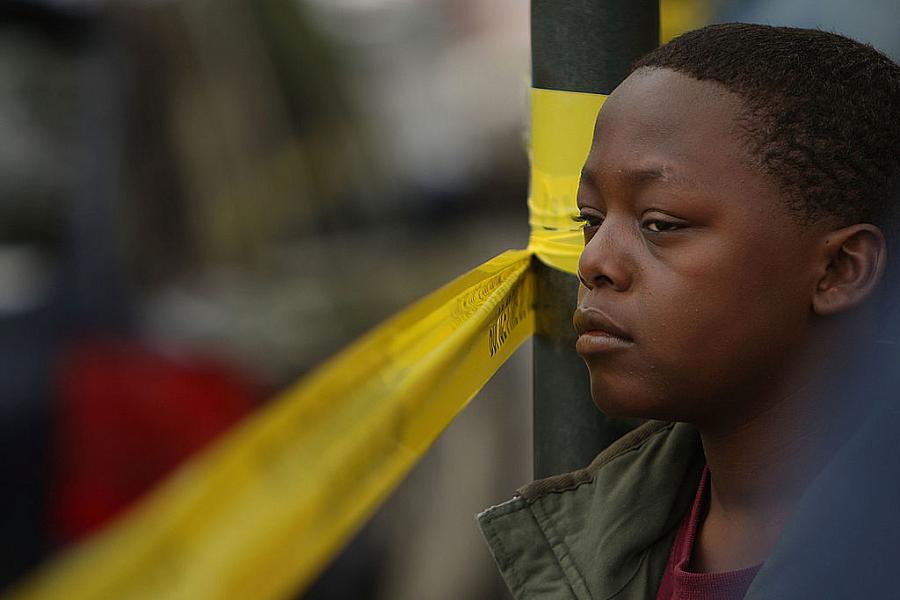In Buffalo, New York, ongoing violence sows epidemic of childhood trauma

Photo: Spencer Platt/Getty Images
Walk into any inner city classroom and ask who has been touched by violence. Odds are good that nearly every child – if not all – will put a hand up.
A recent survey of high school students in the Buffalo Public Schools showed that roughly one in three had seen someone shot, stabbed or assaulted in their neighborhood.
Many more children have been exposed to crime and violence in their communities, forced to walk through drug corridors or past crime scenes to get to school. Some have lost loved ones to street crime. Others fear leaving their homes, trapped in neighborhoods where the sound of gunshots shatters any semblance of security.
Their stories are haunting.
A 14-year-old boy who carries a pocketknife to school for protection in case he runs into trouble in the neighborhood.
A high school junior who returned home from school one day to find his mother murdered.
A family struggling to help a 7-year-old comprehend the death of her uncle, who was gunned down in a drive-by shooting outside a teen dance when he was just 16. The boy died in the arms of his brother, who then dropped out of school and got caught up in crime himself.
“He became the person that murdered Matthew,” their mother said. “He started going on the wild other side. I think it was out of anger that the streets took his little brother.”
“He became the shooter.”
Their stories share a common thread — how deeply violence touches even the youngest children and can set the course for their future.
The stress of growing up in high-crime neighborhoods and being exposed to violence takes an incredible toll on children physically, mentally and emotionally. Students who experience traumatic events are more likely to exhibit behavior problems, be suspended, have poor attendance and be retained a grade level. Increasingly, educators are acknowledging trauma as a key obstacle to overcome in order for children to be successful.
And in the past decade, what educators have long observed in the classroom is being supported by scientific research. How trauma affects inner city children has become the focus of studies once reserved for combat veterans.
A growing body of scientific research shows that trauma not only affects emotional health and behavior, but causes illness and even stifles brain development in young children. Along with its effect on brain growth and mental health, exposure to violence is linked to a range of other diseases, including heart and lung problems and diabetes. It can also shorten a person’s lifespan.
Research is also now showing that vast numbers of children are affected. A 2009 national survey conducted by the Department of Justice’s Defending Children Initiative found that 60 percent of children were exposed to violence within the previous year.
CDC researchers say children living in the inner city suffer from post-traumatic stress disorder at higher rates than combat veterans.
The issue can be particularly acute in poor cities like Buffalo, where poverty often correlates with exposure to crime and violence. Buffalo’s child poverty rate of 47.3 percent is the third-highest of the country’s largest cities.
The city also has one of the highest murder rates – 23.22 per 100,000 people – in the country. In the first five months of 2016, there were enough shootings to make for one every 37 hours.
With support from the 2016 National Fellowship, The Buffalo News is embarking on a project that aims to demonstrate not only the scope of the issue, but pinpoint specific outcomes for students who live in some of the city’s most crime-ridden communities.
The News has obtained data that will allow us to look for correlations between crime in various city neighborhoods and academic outcomes that can determine a student’s success. We also have access to data that will let us look for potential correlations between neighborhood crime and student mental health referrals.
We plan to couple this unique data analysis with stories of young people from within our community and how their lives have been touched by violence. We will equip them with the tools and training to document their own experiences and publish them as part of the project.
Ultimately, the goal is to raise awareness of this issue facing too many children in the community, and hopefully spur positive action.
For too many young people, trauma truly can become a life or death matter.

